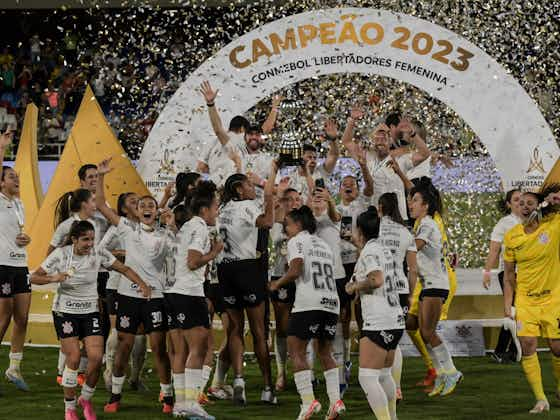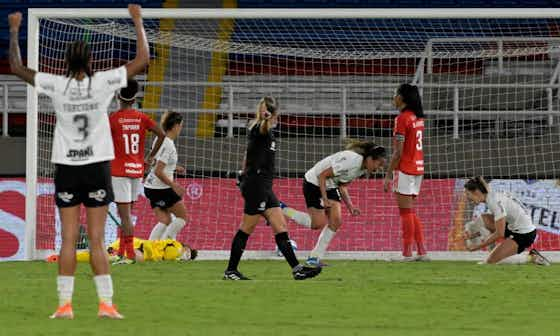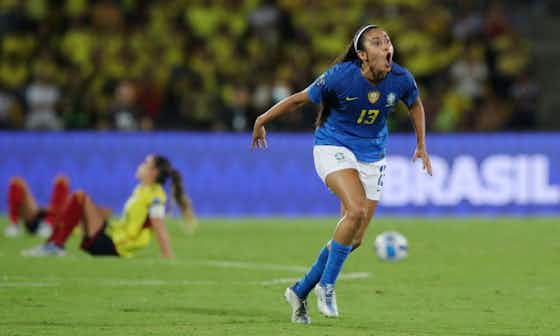The Guardian
·25 October 2023
Brazil clubs dominate Libertadores Femenina but what does future hold?

In partnership with
Yahoo sportsThe Guardian
·25 October 2023

Colombian women’s football fans in Santiago de Cali were in for a different show when they attended the Estadio Olímpico Pascual Guerrero on Saturday night. A Brazilian derby unfolded in the Conmebol Libertadores Femenina final – where Corinthians beat Palmeiras to win their fourth title, having also conquered the continent in 2017, 2019 and 2021. However, even though there is a clear hegemony of Brazilian sides in South American club football, players have noticed improvements in other countries.
“I think Colombia nowadays has the best teams,” says Tamires, the Corinthians left-back and one of Brazil’s captains. “Whenever we play them, it is really hard. There are also Boca Juniors in Argentina, who reached the final [last year]. There are also the fans, supporting their countries and clubs and breaking records in Peru and Colombia.” For her, the fact that Brazilian clubs such as Corinthians have been investing harder in the women’s game can serve as an inspiration for other countries and leagues.
“Brazil is shifting things,” the 36-year-old says. “The Brazilian FA has been really helpful in growing the women’s game in our country, the TV sees the potential of everything, clubs have been investing. We, as players, know our responsibility in this process so that we become a reference, so we have to think together to work for the development of the women’s game so that other clubs can invest more in solid strategies.”
There were many complaints from players and fans regarding the competition format. Conmebol has increased the prize money – Corinthians won $1.7m (£1.4m) and Palmeiras $600,000 (£500,000). The federation president, Alejandro Domínguez, has praised the players’ role in developing the women’s game during the tournament.
“There is no doubt we have to thank them for overcoming so much on this path and helping us make sure that future generations are inspired and see football as a sport to develop them,” he said. “Our players have made history, have changed the game and are helping us build our best version of ourselves.”

The 16-team tournament is played over a little more than two weeks. This season it took place from 5-21 October, with games played at the Estadio Olímpico Pascual Guerrero in Cali or the Estadio Metropolitano de Techo in Bogotá. This, alongside weird kick-off times such as 3pm on weekdays, kept many fans from attending.
Tamires agrees the tournament needs to improve. “This is a bad format,” she says. “Not only for the players and for the club, because playing every couple of days is really strenuous. And then there is the issue of not playing a semi-final or a final at home, with a home crowd. We can do more. Maybe if we played a Colombian team we’d have better attendances; if the tournament was better advertised. But whoever was at the stadium was able to watch a great final.”
The 20-year-old Corinthians defender Tarciane, who was sent off during the final and went to the stands to support her teammates, laments the low attendance. There were 3,580 fans at the Pascual Guerrero, a stadium with a capacity of more than 37,000. “We had a final with two Brazilian teams and couldn’t have our fans there to support us,” she says. “This needs to improve for next year.”

The 25-year-old Victória echoes her teammates’ appeals but calls for caution in the process. “Of course we want to see the Libertadores expand and grow even more, and reach an even bigger audience. I think it’s time to review it, but every step needs to be structured so that we can develop and value the women’s game.”
In the Copa América Femenina 2022 final Brazil were challenged for 90 minutes by Colombia – even though they retained their title. The tournament has had nine editions, and Brazil have won eight. This dominance is also reflected at club level but younger players from other countries are at the forefront of the process of closing the gap.
“The game has improved so much and clubs outside of Brazil have invested more,” Tarciane says. “They believe more in the women’s game. We have some younger players in the continent that are already playing really strong football and representing the continent.”
The reference for many of the South American clubs and national teams is what has been done in Europe, with club and international continental tournaments drawing more fans and investment each year. Victória, who had a short spell at Madrid CFF, feels Corinthians are not behind. “I think we can learn a lot from the European women’s football culture, on how to behave, on maturing and enhancing the game,” she says. “But South American clubs don’t have to look far to find inspiration.” Tamires, who has been playing for Brazil for the past decade, agrees.
“South American clubs need to see the importance of giving better structure to players, investing in academy football. I am sure there are many girls who dream of becoming great footballers one day. If we invest in these kids, if we support and give better conditions to players, this will definitely change the scenario.”
Katie McCabe’s brilliant shot in Arsenal’s 2-1 win over Bristol City was something else. The Irish winger has scored three times in the past two games.
This is an extract of our free weekly women’s football email, Moving the Goalposts. To subscribe to the full edition just visit this page and follow the instructions.
Have a question for our writers – or want to suggest a topic to cover? Email moving.goalposts@theguardian.com.


Live





























































